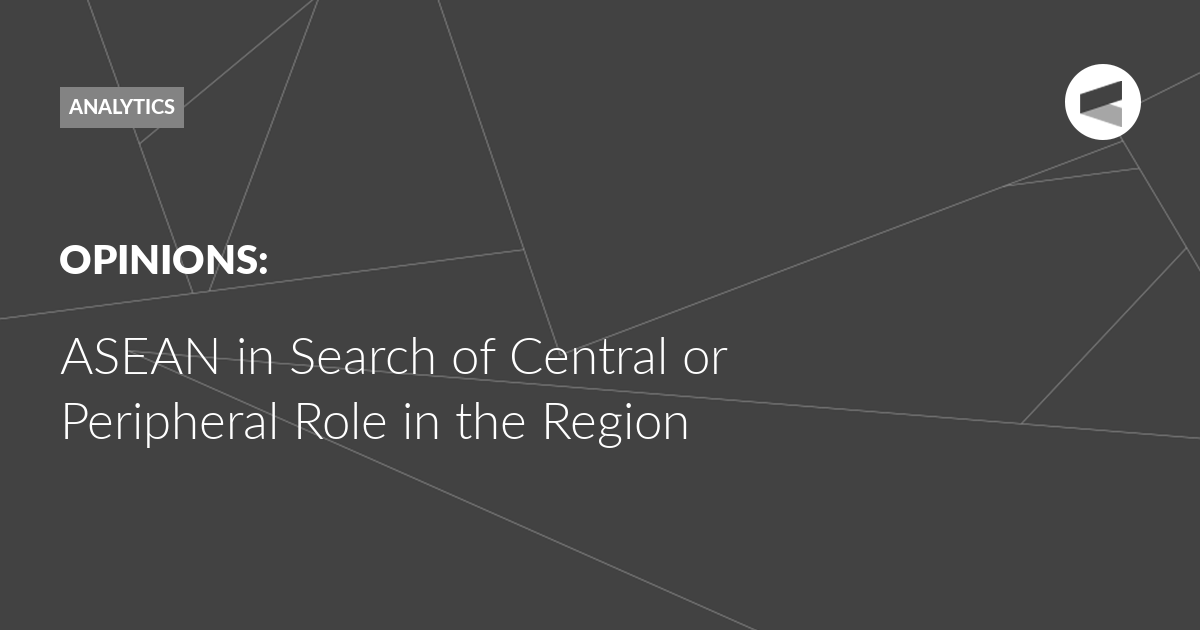The degradation of US-China relations and ASEAN’s inability to effectively cope with the most sensitive security challenges have called into question the central role of the Association and created a fundamental dilemma for the ASEAN – how to organically fit into the emerging regional and global order and not lose its relevance, writes Alexander Korolev.
During the Cold War, the centre of gravity of the confrontation between the US and the USSR was in Europe, but Southeast Asia could not avoid immediate security threats. This circumstance largely forced the Association to formulate and in practice “sharpen” its basic principles, in other words, to follow its own “ASEAN Way”. The key pillars of the Association were to maintain its status as a neutral bloc and protect the internal affairs of member-countries from the interference of external players. This was reflected in the Zone of Peace, Freedom and Neutrality Declaration in Southeast Asia (ZOPFAN), adopted in 1971.
A similar logic developed for the countries of Southeast Asia following the collapse of the USSR, when after many years a “vacuum” of leadership emerged in the region, which was gradually filled by major players – the United States and China. However, the period from the early 1990s until Donald Trump’s first term was not overshadowed by tough confrontation between Washington and Beijing or its direct projection onto Southeast Asia. This allowed the ASEAN countries to remain in a relative zone of geopolitical comfort for many years, benefiting from the rivalry between Washington and Beijing and simultaneously increasing their political capital in the form of flagship initiatives, agreements and various multilateral formats. Thus, in 1994, the ASEAN Regional Forum on Security was created, and in 1997, the ASEAN+3 dialogue format to combat the consequences of the Asian economic crisis. In 2002, the Declaration on the Conduct of Parties in the South China Sea was adopted as a conceptual vision for resolving the territorial conflict with China. In 2005, the East Asia Summit (EAS) was established, which at that time united the “ten” ASEAN members and six dialogue partners. Finally, in 2010, the first ASEAN Defence Ministers’ Meeting in an expanded format (ADMM Plus) was held.
With ASEAN’s increased activity addressing external affairs and amid the dynamic process of institution-building, the term “central role” appeared in the diplomatic lexicon of the Association. It was first used in official ASEAN documents in 2006 following a meeting of the ASEAN Economic Ministers. It was then enshrined in the ASEAN Charter of 2008. The economic component of “centrality” was supplemented by a general strategic one, which turned the Association, as conceived by its member countries, into a key driving force in interaction with external partners.
Since then, at the expert and official levels, this term has been associated not only with ASEAN’s ability to build a multilateral dialogue with foreign partners and contribute to maintaining a stable security and economic architecture in the Asia-Pacific region, but also to maintain unity within the Association. The latter element is the main problem currently facing the Association.
ASEAN and the “Old-Age Crisis”
ASEAN itself has become a hostage to its own image, which it has been crafting for many years. The characteristics that were held up as an example for the Association (adaptability to the external environment, flexibility, consideration of the individual characteristics of member countries) have in recent years become a symbol of failure and crises, with which ASEAN has become increasingly associated in recent years.
This state of affairs is a consequence of a number of external and internal factors facing ASEAN.
First, there is the consistent strengthening of China’s power on the global stage and in Southeast Asia, particularly with the arrival of Xi Jinping and due to the degradation of US-China relations since Donald Trump came to power in the US. With the onset of the trade war and the promotion of US Indo-Pacific strategy as a means of containing China, ASEAN has increasingly come to be perceived as an object and, to a certain extent, a product of the US-Chinese rivalry, rather than an independent and self-sufficient entity on the world stage. It is characteristic that in recent years, there has been increasing talk that over time, the ASEAN countries will be forced to make a choice in favour of Beijing or Washington as relations between the US and China further deteriorate.
Second, Donald Trump during his first presidential term effectively nullified Barack Obama’s strategy towards ASEAN, which was based on the recognition of ASEAN’s central role in the regional security architecture and economy, maximum US involvement in ASEAN-centric dialogue formats and the participation of the US head of state in various summits of the Association. Trump has ignored the ASEAN’s multilateral diplomacy, which was a painful blow to the positioning of the Association and its subjectivity. It is no coincidence that under Trump, the post of US Permanent Ambassador to ASEAN has remained vacant.
Third, in many ways ASEAN has hit the ceiling of its capabilities amid unreasonably high expectations. Regarding external relations, the main processes of institution-building have been completed. The Association has managed to form a ramified system in the form of free trade zones with a number of leading countries, various dialogue partnerships and platforms like the EAS. Individual point changes within these formats will not cause much excitement and will not create tangible reputational benefits for ASEAN. At the same time, the focus on deepening institutional processes within the Association itself has not fully justified itself. For example, within the framework of the ASEAN Economic Community created in 2015, the participating countries have set the task of turning the Association into a single market and production base by 2025. However, in fact, the Association is “stuck” at the first stage of economic integration – a free trade area, although more than 30 years have passed since the ratification of the FTA agreement.
Finally, ASEAN is facing two interrelated problems – a crisis of unity and a reduction of diplomatic resources. They tie the hands of the Association in choosing an effective and coordinated response to growing security challenges. Here it is appropriate to cite three major pain points for ASEAN – the crisis in Myanmar, the conflict in the South China Sea and the militarisation of the Indo-Pacific region.
The Valdai Discussion Club was established in 2004. It is named after Lake Valdai, which is located close to Veliky Novgorod, where the Club’s first meeting took place.
Please visit the firm link to site






